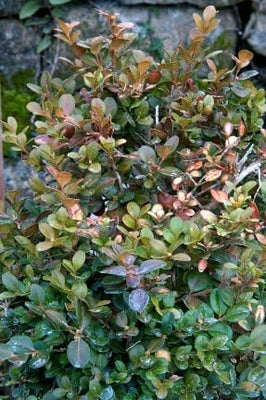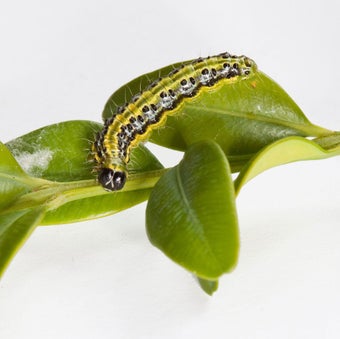
Quick facts
Common name - Box problems
Scientific name - Various
Plants affected - Box, Buxus balearica, B. sempervirens, B. microphylla
Main symptoms - Various
Most active - All year
Image gallery
Here are some images of the diseases and invertebrates common to box.

Box problems
We have detailed advice profiles on many of these problems - just follow the links where present to read more.
Diseases of box
Box blight (Calonectria pseudonaviculata and C. henricotiae)
Watch for leaf spots, stem dieback and bare patches which are tell-tale signs of box blight.
Volutella blight
Volutella blight is a disease of box caused by the fungus Pseudonectria buxi. Volutella blight has similar symptoms (twig and leaf death) to the more serious box blight, although the characteristic black streaks of box blight do not form and defoliation is not common. Spore masses, developing on the undersides of affected leaves in wet conditions, are pink for Volutella blight and white for box blight.
P. buxi requires wounds for infection and is associated with environmental stress or clipping in wet weather. It is not a serious disease and improving cultural conditions will usually lead to plant recovery. Diseased branches should be pruned out when the foliage is dry, and old fallen leaves removed from the interior of affected plants.
Box rust
Box rust is caused by a fungus called Puccinia buxi. This is not particularly troublesome and seldom causes serious problems.
It can be seen as thickened rusty blister-like pustules on both sides of the leaves. The fungus forms only one type of spore, which develops in autumn and winter and breaks through the epidermis of the leaves in spring. New leaves are infected in the spring and early summer. The fungus continues to grow during the summer and autumn and as a result the infected spots become thicker. Box rust does not have an alternate host.
To control it clip off the affected shoots and dispose of them - it's best to wait until the start of a forecast spell of a few dry days before doing so.
Macrophoma leaf spot
Macrophoma leaf spot is caused by the fungus Macrophoma candollei. It is a weakly pathogenic fungus, resulting in numerous tiny black raised fruiting bodies found on dying or dead straw-coloured leaves. Like Volutella blight, it is associated with plants under stress and is easily managed by improving cultural conditions.
Phytophthora root rot
Both new and well established plants may fail completely for no obvious reason. This may be due to a soil-borne disease called Phytophthora root rot.
Invertebrates damaging to box
The RHS recommends that you don't use pesticides. Most pesticides (including organic types) reduce biodiversity, including natural enemies, impact soil health and have wider adverse environmental effects.
Box sucker
This insect causes the leaves to become cup-shaped and in spring there are splashes of a waxy white material on the foliage which can also be blown around in the wind. In most cases this insect can be tolerated as it has a very limited effect on plant growth.
Box tree caterpillar
The caterpillars of this moth can completely defoliate plants. First found damaging plants in gardens in 2011, the moth has since become more widespread and is a significant defoliator of box plants throughout much of South East England and beyond. It is now considered a common resident. For more information and to submit reports of this insect visit the box tree caterpillar profile on the link above.
Box leaf-mining gall midge
The box leaf-mining gall midge, Monarthropalpus flavus, is uncommon in Britain but occasionally feeding damage is observed. This tiny fly deposits its eggs in the new leaves during late April - May. The larvae feed inside the foliage, causing a yellowish discolouration on the upper leaf surface. The lower leaf surface develops a slight swelling in the area affected by the larva's feeding. The yellow larvae are up to 3 mm long and they feed inside the leaves during summer – winter before pupating within the mines in spring. Several mines can develop in a leaf and heavily damaged ones often drop off.
Whilst the damage caused can be unsightly it rarely affects the vigour of plants and it can usually be tolerated.
Mussel scale
Mussel scale, Lepidosaphes ulmi, is a sap-sucking insect that is found on a range of woody plants, including box, apple, hawthorn, Ceanothus, Cornus and Cotoneaster. The blackish-brown shells or scales are shaped like mussels, up to 3mm in length, and are attached mainly to the bark but sometimes they spread to the foliage. Heavy infestations can result in plants dying back.
Box red spider mite
A fine whitish mottling on the foliage of box plants can be caused by the box red spider mite, Eurytetranychus buxi, a mite that is specific to box. This tiny creature feeds by sucking sap from the undersides of the leaves, particularly during spring and early summer. By late summer it dies out and the mite overwinters as eggs, which are laid on the stems and underside of leaves.
Box tree red spider mite is difficult to control. Fortunately, although the mottling may be considered unsightly, this mite does not cause serious damage to the plants and so it can be tolerated.
Fluted scale
Fluted scale, Icerya purchasi, is a sap-feeding insect which, until recently, was largely confined to heated greenhouses. It still an uncommon problem, especially on outdoor plants, however in recent years it has become more widespread. This insect has a very wide range of host plants, including box, and heavy infestations can cause a lack of vigour. The adult scales are flat, oval insects about 4-5 mm long and reddish brown in colour. The females deposit their eggs amongst mounds of white waxy fibres that have a grooved appearance, these can be found on the stems and foliage. The scales excrete a sticky honeydew on which black sooty moulds can grow.
Environmental stresses
When the leaves take on distinctive yellow tips or an orange or bronze colouration, it suggests the plants are under environmental stress.
Many shrubs can suffer brown leaves. Trying to diagnose the problem as soon as possible may help save the plant.















